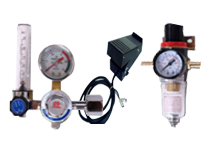
GTAW Process: Personal Protective Equipment
For the Beginner, TIG welding does offer an exciting and sometimes frustrating experience. It's encouraging to know, that with practice and time, those first ugly, ropey welds, that resemble 4 day old road kill can be often be turned into nice, tight little stacks of dimes. Getting a handle on TIG welding equipment and what is required to TIG weld properly helps to prepare the first timer to get up and running as quickly as possible. There are other items such as personal protective equipment, and welding accessories that must be purchased along with the welding machine to get safely started.
Of upmost importance, the newcomer will require substantial safety gear. A GOOD auto darkening helmet (also referred to as a “hood”) is the first requirement. Do not rely on cheap 2 sensor designs to TIG weld. A more expensive 2 sensor design can be used, but if a lot of low amp TIG welding will be done (below 30 amps or so) , a 3 or 4 sensor design will be required for maximum sensitivity. A good welding helmet will usually start around 175.00 and can exceed 700.00 dollars. Clarity is of concern as well. Don’t automatically go for the largest viewing area. Instead, look for clarity and quality over a “big” lens. Consider a quality pair of safety glasses as well. Some are available, that while clear, do offer protection from stray arc rays that tend to reflect off other objects in the area and make their way under the welding hood. Gloves while important are more subjective. TIG gloves come in many styles, lengths and materials. Commonly, you’ll see goat skin and deer skin as a common leather component, to maximize sensitivity and flexibility. However, TIG can be a hot process and too thin of a glove can lead to serious burns. Don’t be tempted to leave off the gloves. Skin cancer is a real risk. The welding arc rays are more intense than the sun’s and can quickly cause painful sunburn, in a matter of minutes. A rule of thumb in considering a good TIG glove is that you can pick up a dime off a flat surface with the gloves on. Another essential item for protection is a welding jacket, or at the very minimum, welding sleeves. Welding jackets come in a variety of styles: capes, jackets, lab coats, made from leather, fire resistant fabric, denim or any combination thereof. The idea is to provide the most protection with a level of comfort that safeguards the worker. Welding sleeves do provide a higher level of comfort and freedom of movement especially in hot areas, but may not offer adequate protection against stray rays that can penetrate thin shirts. If sleeves are to be worn, a minimum of a heavy denim shirt should be worn. Regular T-shirts and other shirts still transmit much of the harmful radiation.






